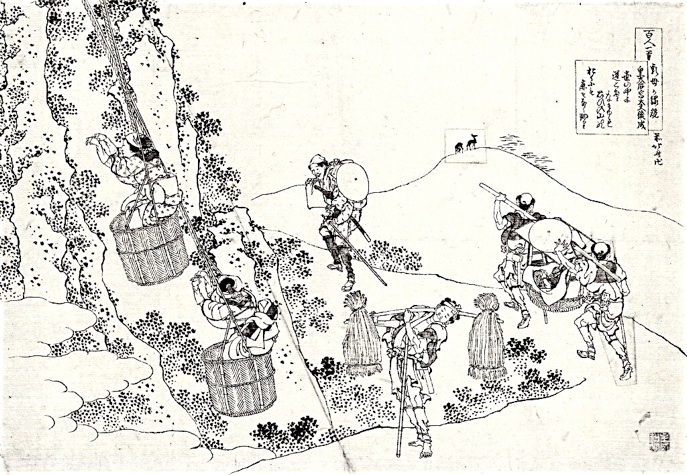皇太后宮大夫俊成


世の中よ
道こそなけれ
思ひ入る
山の奥にも
鹿ぞ鳴くなる
こうたいごうぐうのだいぶとしなり
よのなかよ
みちこそなけれ
おもいいる
やまのおくにも
しかぞなくなる
Fujiwara no Toshinari
In this world for sure
There is no right course.
I do want to live
Deep in the mountains,
But there the shika cry.
Fujiwara no Toshinari (1114 - 1204), also known as Fujiwara no Shunzei or Shakua (the name he adopted when he became a priest in 1176), was ‘Chamberlain to the Empress Dowager’ (Kotaigo-gu no Daibu). Teika (poem 97) was his son. He compiled the Senzai Wakashu for emperor Go-Shirakawa. The Choshu Eiso is his personal poetry collection and there are hundreds of his poems in imperial anthologies. He was also very active as a judge in poetry contests.
This poem is said to hedge on the pivot-words omoi iru. Here are the interpretations Yoshua Mostow (Pictures of the Heart) discovered in old commentaries about this:
-
1.The poet is possessed by the idea of the ‘melancholy’ (usa) of the world
-
2.He is possessed by the idea of his own mortality (wa ga mi no hakanasa)
-
3.Bemoaning the political disorder of the world, he opts for reclusion.
The last point can refer to the strife between the Minamoto and Taira clans, heralding the end of the Heian period.
Iru can mean ‘put one’s heart into’, ‘enter’, ‘need’ or ‘live’, all nicely combined in omoi iru as ‘think of entering the life of’. There is a play with words in naka (in the middle of), nakere (is not) and nakunaru (again with a double meaning ‘weep’ or ‘sing’).
See also poem 5 for the cry of the shika (or sika) deer.
The poetic style used here is that of yugen (one of the ten orthodox styles of poetry, which focused on conveying romantic emotion, with characteristic undertones of nostalgia and regret); his style was sometimes summarized as ‘old diction, new treatment’. He wrote that poems ‘should somehow produce an effect of both charm and of mystery and depth’. It is all about the power to evoke, rather than the ability to state directly.
In Hokusai’s drawing we see a man being transported into the mountains in a palanquin. Two men seem very much interested in or amused at the women doing hard and dangerous labour collecting moss from the rocks. In the distance we see the sika deer.
There is a saying in Japanese which could be what Hokusai had in mind: ‘korogaru ishi ni koke musazu’, ‘a rolling stone gathers no moss’. For the Japanese, moss is something to be admired. Associated with beauty, moss grows on rocks and on the sites of old temples (like the Koke-dera in Kyoto). Yet the stone that continues to tumble will never have moss. So this expression is often used to admonish others to stay put, to continue with what one is doing. The Japanese meaning of this expression is the opposite of ours.
So it is possible that Hokusai was again having some fun, by comparing the rolling stone, the man in the palanquin, to the women collecting moss (a double pun - which could explain why the men seem amused).
Hokusai

